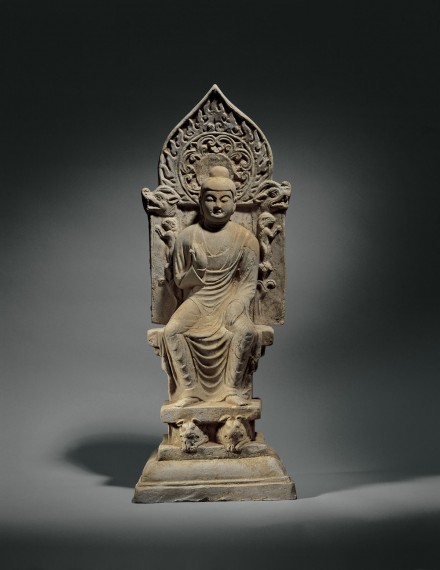J.J. Lally & Co., Oriental Art / New York City, New York
MenuPast Exhibition
Two Thousand Years of Chinese Sculpture
March 17-29, 2008

16.
A TERRACOTTA FIGURE OF MAITREYA
Sui/ Early Tang Dynasty, 7th Century
the Buddha of the future shown with youthful face and calm, contented expression, his close-cropped plain hair piled up over a rounded usnisa, seated on a Sumeru-type throne raised on a stepped plinth, with both legs pendant in bhadrasana, the so-called European-style posture, with right hand raised to grasp his collar and left hand resting on his thigh, wearing plain monastic robes draped over his shoulders, clinging to his body and falling in symmetrical pleated folds to his bare feet, with a pair of crouching lions supporting the pedestal under his feet and a pair of earth spirits supporting the pedestal in the corresponding position at the back under a lotus-petal form niche centered with a small seated Buddha, the large separate mandorla moulded in relief with a foliate halo around Maitreya’s head surrounded by rounded curling flames filling a petal-shaped pointed panel resting on a pair of dragon heads above twin figures of fantastic long-horned beasts each standing on a floral spray, all moulded from pinkish-buff pottery and showing remains of red and black pigment over white slip.
Height 22 3⁄8 inches (56.8 cm)
A very similar moulded pottery seated Maitreya on throne was exhibited in New York at the Herbert J. Devine Galleries and illustrated by Mueller in the catalogue of The Sunglin Collection of Chinese Art and Archaeology, New York, 1930, p. 82, no. H-611, with description on p. 32.
A smaller figure of a standing bodhisattva on a separate lotus-petal plinth, moulded in a very similar style from the same type of buff pottery and showing similar remains of pigment, excavated in 1976 at the site of Longhuasi temple in Zhangguan village, Bo’xing county and now in the Bo’xing County Museum, was included in the special exhibition commemorating the 10th anniversary of the Miho Museum and illustrated in the catalogue entitled Buddhist Sculpture from Shandong Province, China, Shigaraki, 2007, p. 99, no. 60, with description and discussion on p. 171 where the author mentions that a number of these moulded pottery figures thought to have been created from the same mould were discovered at the Longhuasi site in Bo’xing and elsewhere in Shandong, including a similar figure bearing an inscription dated to the third year of Renshou, corresponding to A.D. 603. The bodhisattva figure dated by inscription to A.D. 603 is illustrated by Matsubara in Chūgoku Bukkyō chokokushi ron (Historical Discussion of Chinese Buddhist Sculpture), Tokyo, 1995, vol. II, pl. 571, together with one of the figures excavated at Bo’xing. Three more very similar moulded pottery figures of standing bodhisattvas are illustrated by Krahl, Chinese Ceramics from the Meiyintang Collection, Vol. Three (I), London, 2006, pp. 212-213, nos. 1223 and 1224.
Compare also the small sandstone figure of Maitreya excavated at Hancheng, Shaanxi, 1959, shown with hands in the same positions as the present example, seated on a throne raised on a block with a Tang dynasty dedicatory inscription dated to the first year of Xianheng, corresponding to A.D. 670, which was exhibited at the China Institute Gallery and illustrated by Juliano in the catalogue, Buddhist Sculpture from China: Selections from the Xi’an Beilin Museum, New York, 2007, p. 91, no. 38.
隋 / 唐早期 白陶彌勒佛坐像 高 56.8 厘米
16.
A TERRACOTTA FIGURE OF MAITREYA
Sui/ Early Tang Dynasty, 7th Century
Height 22 3⁄8 inches (56.8 cm)